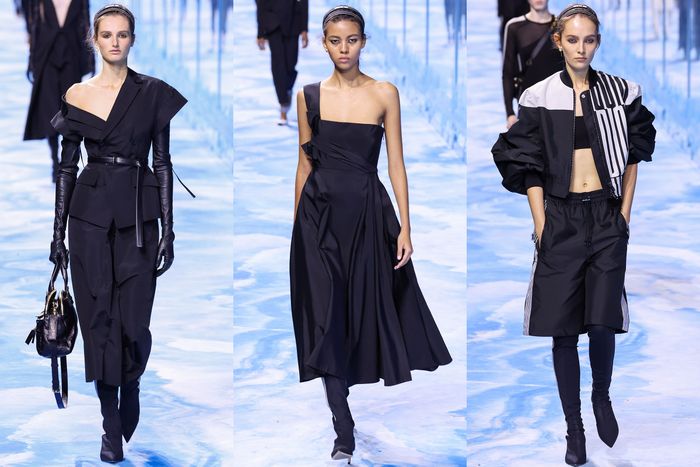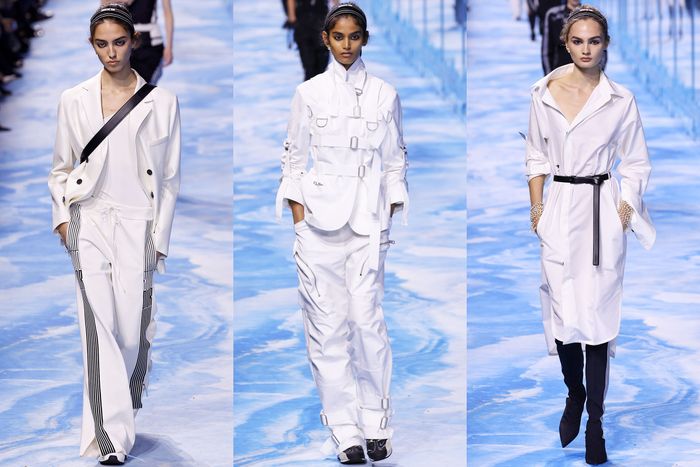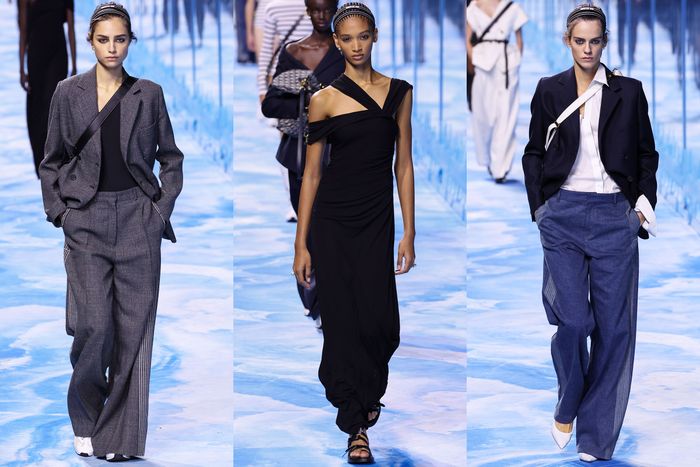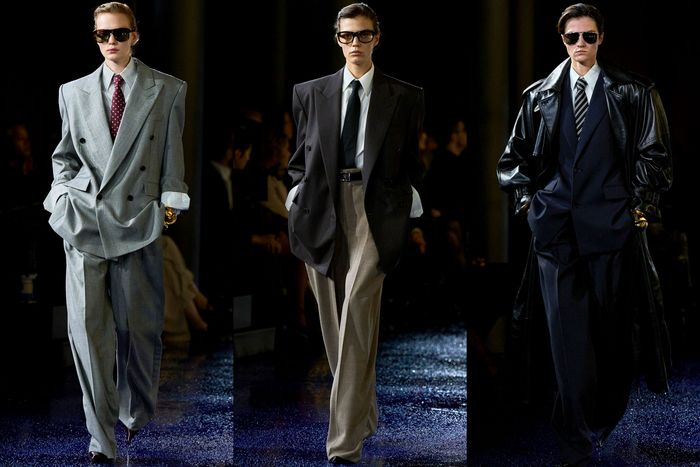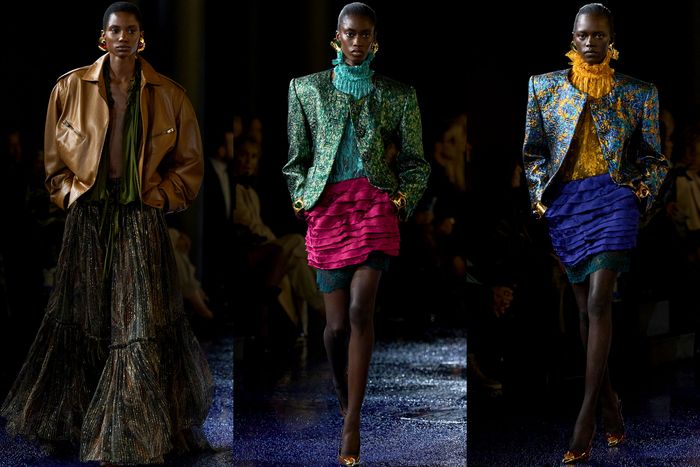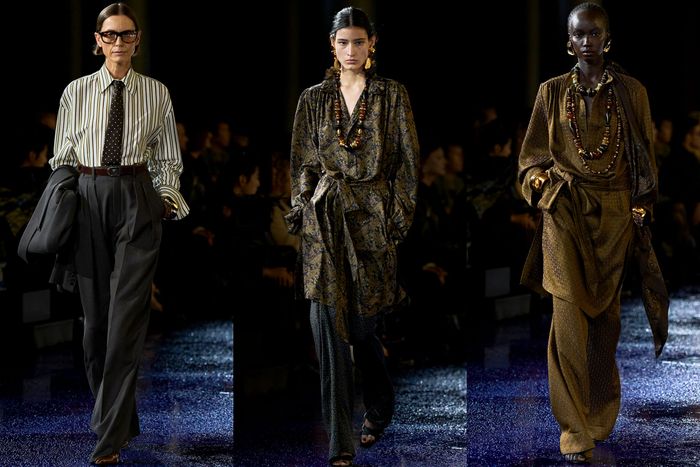Fashion
Dior and Saint Laurent Show Sharp Collections
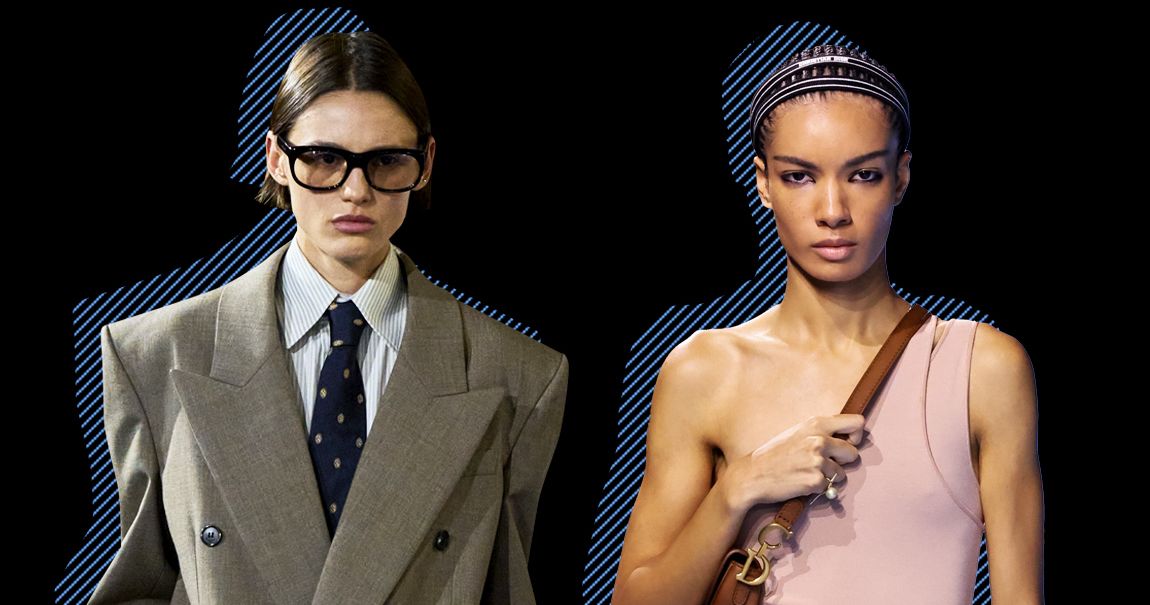
left to right Saint Laurent, Dior
Photo-Illustration: by The Cut; Photos: Courtesy of Saint Laurent; Getty Images
The big shows that opened the Paris spring collections, Dior and Saint Laurent, illustrated again why today’s creative directors often function more as curators than designers. On Tuesday night, on an outdoor runway drenched with rain, Anthony Vaccarello sent out an homage not only to Yves Saint Laurent’s famous pantsuits but to the couturier himself. Wearing horn rims, their hair slicked or pinned back — or styled in shaggy, ’70s-era cuts — the models resembled the many sober, delicate faces of Yves seen in photographs.
Dior’s Maria Grazia Chiuri plucked things from the archive that asserted Christian Dior’s modernity along with his wide-ranging obsessions and fancies. In 1951, he designed a dress called Amazone, a close-fitting draped look that drew on the asymmetrical cut of a historical woman’s riding skirt, so she could sit properly on a side saddle. Riding costumes were probably the very first style that women adapted from the male wardrobe, dating at least from the 18th century and gaining greater visibility in the 19th.
Dior.
Photo: Getty Images
Chiuri also discovered that Dior had a brief mania, around 1949–50, for black opera gloves that reached up to the shoulders, a style that would seem to belong more to early, subversive Jean Paul Gaultier. Her leather gloves added an element of athletic strength to her sporty black dresses, many in crisp but lightweight faille. Chiuri also unearthed a block-style Dior logo from around 1970 with lines running up and down from the letters and then converted them into stripes racing down the sides of knit pants. And since so much of the collection was rooted in sportswear, Chiuri also in a way paid tribute to the largely overlooked designer Philippe Guy Bourget, who worked side by side with Marc Bohan, a successor of Dior, and developed Miss Dior and a sports line, mostly for ski clothes and outerwear. Bourget went on to design Chanel after Coco Chanel’s death and before Karl Lagerfeld’s arrival.
Dior
Photo: Getty Images
The centerpiece of the Dior show, held as usual in a huge tent behind the Rodin Museum, was a 70-meter-long tunnel made of glass and metal, where an Italian artist and competitive archer named SAGG Napoli fired arrows at a target while the models walked. It was thrilling to watch her take aim — with the view of celebrity guests and LVMH honchos on the other side of the glass — and the choice of SAGG Napoli, who works in video, performance and sculpture, goes hand in hand with Chiuri’s feminism, if not her tough, practical nature and dry sense of humor.
In the past, she has invited female acrobats and dancers to perform. How could a female artist-archer be dorky? Not at all. Chiuri refuses to be confined or underestimated. I asked her why many of her recent ready-to-wear collections have been predominantly black and white with splashes of tan and perhaps gold. She shrugged and replied that it’s what she herself likes to wear, her generation. And black is more wearable, durable, than color. It’s also a safe bet in a challenging luxury market.
Dior
Photo: Getty Images
Safe or not, this was a sharp collection, in part because of the sleek opening dresses with wide cap sleeves, and the off-the-shoulder jackets and cotton shirts, and the easy yet polished jackets and track pants (with those racing side stripes) in high-quality compacted knit. Chiuri retold a story of female strength that’s as old as the Greeks, and she kept it as agile and graceful as the artist with her high-tech bow.
As it happens, the choices of Vaccarello and Chiuri this season anticipate a major costume exhibition planned for the fall of 2026 at the Musee Galliera in Paris on how women adopted and adapted male dress from the 18th century on, though mainly during the fantastic, disruptive 19th century. I had a peek on Monday in the Galliera archive at some of the garments, like frock coats and dandy vests, that women remade for themselves and will be in the show. One area that curators intend to consider, based partly on photographic evidence from both the States and Europe, is early lesbian fashion. The exhibit could not be more timely.
Saint Laurent
Photo: Courtesy of Saint Laurent
A rainstorm erupted shortly before the Saint Laurent show, and guests arrived to workers mopping up with shop vacs and squeegee brooms. A steady drip of water from the portico roof fell on my head. And when my seatmate and I attempted to open our umbrellas, we were scolded by those behind us. Several people slipped and fell.
Saint Laurent
Photo: Courtesy of Saint Laurent
Still, kudos to Vaccarello for a clever play on Yves’s image, captured by so many artists including Warhol. I still remember Saint Laurent on the day in 2000 when he shyly and rather frailly took me around his home on the rue de Babylone, not far in fact from the show site. I loved Vaccarello’s dexterous take on the male trouser suit, in part because the lightweight fabrics were so exquisite and varied in tone. Many suits had the ballast of a leather bomber or a trench.
Saint Laurent
Photo: Courtesy of Saint Laurent
The tailoring follows in the mode of Matthieu Blazy’s Bottega Veneta show, though the look is unmistakably Saint Laurent, as were the more feminine brocade jackets and long, Scheherazade skirts in a sheer metallic-shot paisley, and silk-print evening pajamas with tunic tops. Vacarello, though, should have skipped the long, glittery skirts, which looked secondhand in an otherwise first-rate collection.
So often, a Vaccarello show can feel like a hammer to a nail as he drives home a single theme. This time, despite the drippy roof, the experience was a sustained and more complex pleasure.

